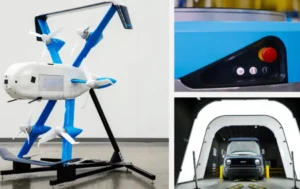
Walmart, the nation's largest grocer, announced plans Wednesday to open five new automated distribution centers as part of its ongoing efforts to strengthen its already commanding position in the $1.1 trillion U.S. grocery market. The move comes as the retail giant continues to invest heavily in its supply chain to meet the evolving needs of its customers.
The new state-of-the-art facilities, averaging 700,000 square feet, will feature advanced automation technology in both ambient and chilled environments, enabling more efficient processing of perishable goods like fruits, vegetables, eggs and frozen items.
Walmart says each high-tech distribution center will be capable of moving double the volume of a traditional warehouse thanks to the robotic systems that store, retrieve and pack items onto pallets for shipping. These distribution centers are an important part of our strategy to modernize our vast supply chain network and better serve our customers.
The automated distribution centers are the latest example of Walmart's efforts to leverage cutting-edge technology to optimize its operations. In recent years, the Bentonville, Arkansas-based company has deployed robots to scan shelves for out-of-stock items, clean floors and unload trucks. It has also expanded its e-commerce capabilities, including in-store pickup, same-day delivery and Walmart+, a subscription service that offers free shipping and other perks.
Walmart's U.S. e-commerce sales rose 24% in the first quarter, driven largely by strong demand for online grocery. The company's grocery business has been a bright spot during the pandemic, as consumers have relied more on Walmart for essentials. Walmart now has over 3,500 stores offering grocery pickup and more than 2,700 stores offering same-day delivery.
But the competition in the grocery delivery space is heating up, with rivals like Amazon, Kroger and Albertsons investing billions to expand their online capabilities. Walmart's move to automate more of its distribution network could help it stay ahead of the pack by making its e-commerce operations more efficient and cost-effective.
As more consumers embrace online grocery shopping and home delivery, the pressure is on for retailers to optimize their supply chains to meet this demand efficiently. Automated warehouses, like the ones Walmart is building, can process orders faster and more accurately than traditional distribution centers that rely on manual labor.
Walmart's announcement comes as the company has been posting strong financial results despite the economic fallout from the pandemic. In the first quarter, Walmart's total revenue rose 2.7% to $138.3 billion, while net income jumped 40% to $6.5 billion. The company has also been expanding its presence in the advertising and financial services sectors as it looks to diversify its revenue streams.
But the retail giant faces challenges on other fronts, including criticism over its labor practices and environmental impact. In recent years, Walmart has faced protests and lawsuits from workers who say they are underpaid and overworked. The company has also been accused of contributing to climate change through its massive carbon footprint.
Walmart has pledged to address these issues through various initiatives, such as raising its minimum wage, expanding benefits and investing in renewable energy. But critics say the company needs to do more to live up to its stated values of social and environmental responsibility.
As Walmart continues to invest in automation and e-commerce to cement its dominance in the grocery industry, it will need to balance these priorities with the needs and concerns of its workers, customers and communities. The success of its automated distribution centers will be just one factor in this complex equation.







